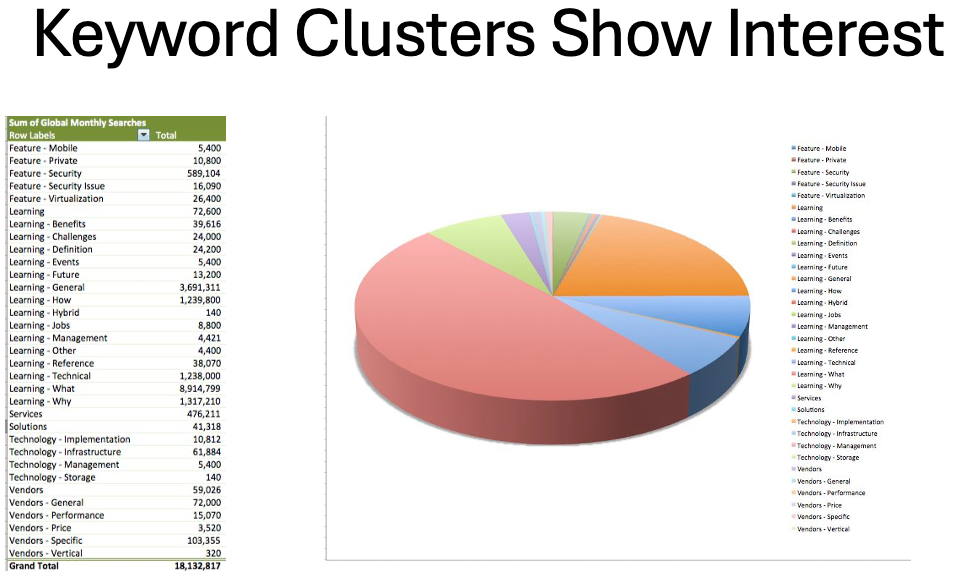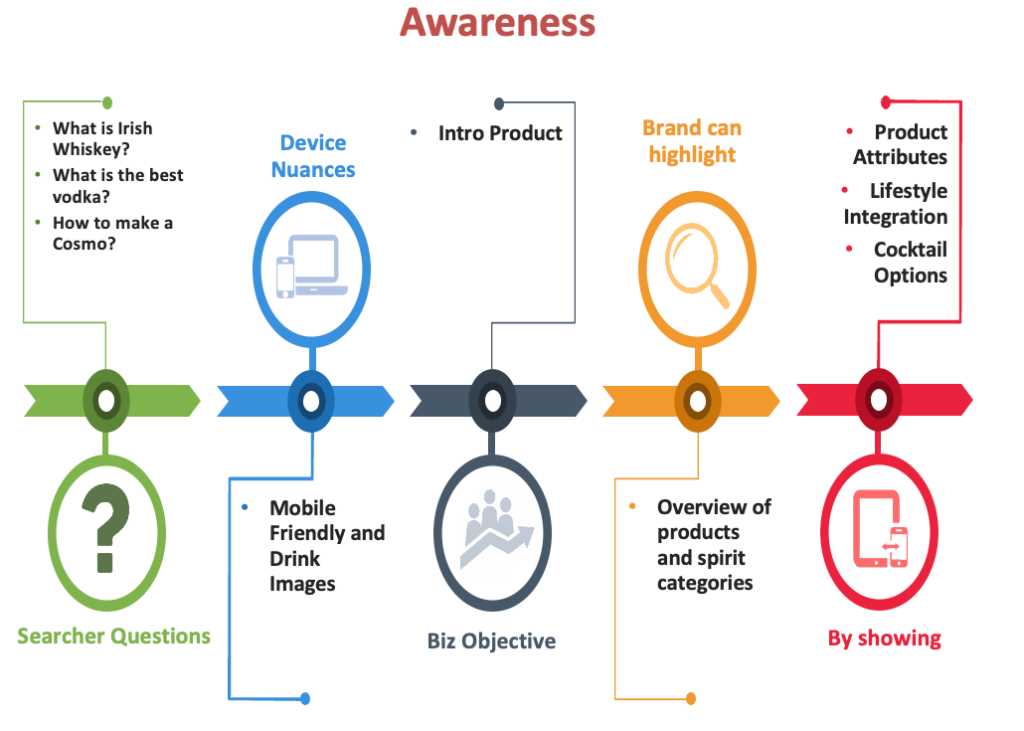“Search engines are not just a marketing tool; they are a direct bridge to a consumer’s intent.”
In my original business school thesis from 1994, I noted that search engines were the only marketing vehicle that allowed us to connect with consumers directly at the point of interest. I suggested that by providing the information they are looking for, you can remove the friction of the purchase process.
One of the most powerful insights from this realization is that searchers are on a mission. They have specific needs or actions they’re hoping to fulfill when they perform a search. Our job, as marketers, is not to shout our message at them but to align our content with their needs. We should always ask: What do searchers really want when they search and are we providing it?
How Understanding Searcher Intent Changed the Way We Worked
In today’s digital marketing landscape, one of the most transformative shifts has been realizing the importance of understanding searcher intent and needs in crafting successful strategies that align with it. Mike Moran and I covered this requirement in 2003 when we first released Search Engine Marketing Inc. going into detail about understanding why they searched, that wype of query and alignment to the buy cycle were all key parts of a successful search program.
This shift, which I refer to as one of my “epiphanies,” has completely reshaped the way businesses approach both paid and organic search. Understanding what people are truly looking for when they conduct a search, and matching that with the right content, has led to dramatic improvements in marketing performance and customer engagement. Let me walk you through the key insights and how they’ve changed the way we approach work.
The Power of Searcher Intent
“A high ranking is worthless if it doesn’t align with what searchers truly want.”
The data showed that 81% of the query variations were related to discount, cheap, and inexpensive hotels, followed by location and features. There it was, plain as day, the gap between what searches wanted and what we were presenting. There were no queries for the most expensive hotels, but 1% of the query volume was related to those queries related to “luxury” and attributes found at costly hotels. The traffic data showed they were getting 100% of those queries, so the models did work, but we needed refinement. We pivoted to focus on the other brands getting #1 and #3, and the click rates were even higher than expected because they specifically focused on the messaging around the discount intent.
A Shift in Mindset: Understanding Why People Click
I remember working with a client in the alcohol industry; they were running paid ads targeting users searching for “12-year-old single malt whiskey.” Could this query have been more specific on what they wanted? It should have been a straightforward match.

Yes, they have their tagline in the message, but the overall message was not to answer the searcher’s question but to fulfill campaign goals. The campaign was trying to get people to join a community of Glenlivet enthusiasts, sign up for tasting events, and follow them on Facebook – there was no indication of a brand preference they wanted information. This ad was irrelevant to someone simply looking for a whiskey purchase. This explained why no one clicked the ad as it was a total mismatch between what the searcher was looking for and the presented offer.
From Keyword Research to Business Intelligence
This misalignment often happens in paid search, where precision targeting opportunities are wasted on content that doesn’t fulfill the user’s need. This situation highlighted the importance of building campaigns based on searcher intent rather than just pushing a brand message. The insights from this searcher intent data allowed us to create a whole business intelligence team dedicated to mining this information. This approach didn’t just win clients; it helped us develop a sustainable business model that was scalable and effective. We began to focus on the context of the search — the user’s journey, the device they were using, and their stage in the purchase process — which ultimately led to higher conversion rates and more satisfied clients.
An essential aspect of understanding searcher intent is realizing that searchers aren’t just clicking because they want to see an ad or read some content. They are clicking because they have a need. Whether that need is to gather information, compare prices, or make a purchase, aligning with that need is crucial. For instance, when looking at a client targeting people searching for “Cisco 3750 switches” using broad match in Google paid search. Mining the variations of this phrase, we discovered that 60% of the searches were related to support, not purchasing. We minimized waste and directed traffic to more relevant content by adjusting the strategy to eliminate unnecessary support ads.
Once we recognized the importance of understanding AND, more importantly, messaging to searcher intent, we built tools to mine this data called CIM Modeling. We went beyond general industry assumptions and looked at people’s queries, focusing on the customer journey and connecting with them. This led to the creation of the Bing Card content models and a patent at IBM that found the path is not linear, and when we identify the multiple queries and intent in a customer journey and try to create content that nudges them to take the next step.
Building Content That Matches the Need
“Content without context is just noise.”
Once we recognized the importance of understanding AND, more importantly, messaging to searcher intent, we built tools to mine this data called CIM Modeling. We went beyond general industry assumptions and looked at people’s queries, focusing on the customer journey and connecting with them. Another breakthrough came when we analyzed the intent and aligned it to the buying cycle phase. From this analysis, we developed the “bingo card” content concept. This idea was inspired by our understanding that users often needed to visit multiple pieces of content before deciding. By identifying which content pieces led users to purchase or enter a lead queue faster, we could optimize the user journey to align with their intent, ultimately increasing conversions. We refined this model at IBM and ultimately received a patent on the process, aligning queries to phases of the buying cycle and their intent and the logical next step in the customer journey and providing content that nudges them to take the next step.
The ability to create content that matches the searcher’s intent is one of the most effective strategies we developed. For example, when we worked with tech clients in the cloud computing space, we noticed a gap in the content. People weren’t searching for product or cloud solution pages; they were looking for answers to basic questions like, What is cloud computing? Once we created our MBA-friendly chart showing that 51% of cloud interest was related to what is followed directly by cloud security, we could change the content. We captured traffic that would have otherwise been lost to more generic content by creating a simple page answering that question.

Similarly, when working with whiskey brands, we found that people didn’t just want to buy whiskey—they wanted to learn about it. Creating educational content, such as “What is Irish Whiskey?” or “How to Make a Cosmopolitan,” became an effective strategy for capturing the interest of searchers and introducing them to the products in a way that felt natural and relevant.
The Importance of Content and Context
This brings us to an essential point: content and context are inseparable. Understanding the searcher’s intent means delivering content that not only answers their questions but does so in a way that aligns with their expectations and where they are in the buying cycle. We saw this when analyzing price and location queries for whiskey sales. By identifying these queries, we could present content that made sense — whether it was about price comparison or availability in nearby stores.

Understand the stages and elements of the buyer’s journey and ensure they are covered. You must align interest with business objectives across device types. This can be a win-win for both the business and the user, but it does require much more thought than just pushing tons of content that matches popular phrases.
Conclusion: A New Approach to Marketing
“The future of marketing isn’t about shouting louder—it’s about listening better.”
The shift in our approach to marketing—from focusing on keyword rankings to understanding searcher intent—has transformed how our agency approaches consulting. By focusing on what people truly want and tailoring content to meet those needs, we have optimized campaigns in a way that benefits both the consumer and the business.
Understanding searcher intent has become the cornerstone of our marketing strategies, from leveraging paid search with laser precision to optimizing content for organic search. The insights we’ve gained from analyzing searcher behavior have enhanced our marketing outcomes and led to the creation of tools and processes that have redefined how we approach client work. By aligning our strategies with the real needs of searchers, we can ensure that our marketing efforts are effective and efficient.